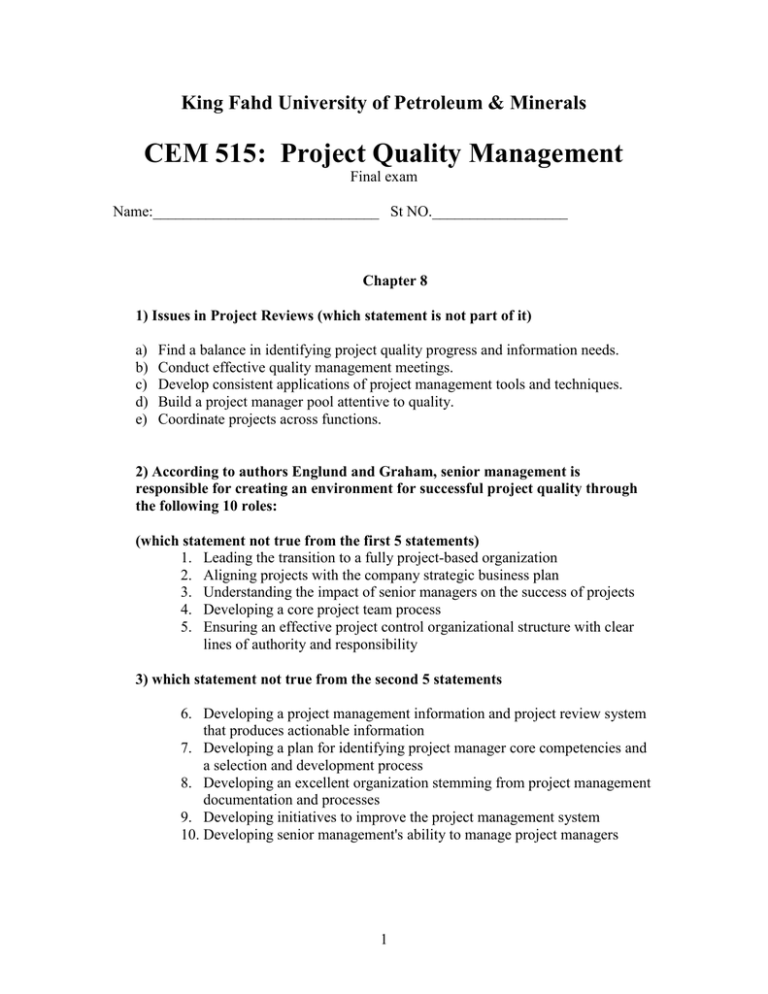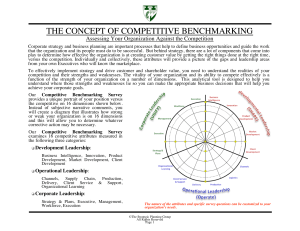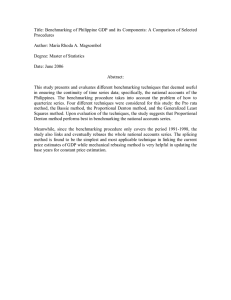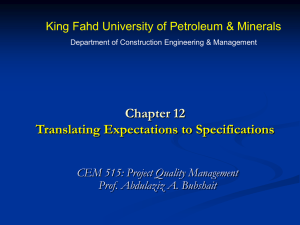CEM 515: Project Quality Management
advertisement

King Fahd University of Petroleum & Minerals CEM 515: Project Quality Management Final exam Name:______________________________ St NO.__________________ Chapter 8 1) Issues in Project Reviews (which statement is not part of it) a) b) c) d) e) Find a balance in identifying project quality progress and information needs. Conduct effective quality management meetings. Develop consistent applications of project management tools and techniques. Build a project manager pool attentive to quality. Coordinate projects across functions. 2) According to authors Englund and Graham, senior management is responsible for creating an environment for successful project quality through the following 10 roles: (which statement not true from the first 5 statements) 1. Leading the transition to a fully project-based organization 2. Aligning projects with the company strategic business plan 3. Understanding the impact of senior managers on the success of projects 4. Developing a core project team process 5. Ensuring an effective project control organizational structure with clear lines of authority and responsibility 3) which statement not true from the second 5 statements 6. Developing a project management information and project review system that produces actionable information 7. Developing a plan for identifying project manager core competencies and a selection and development process 8. Developing an excellent organization stemming from project management documentation and processes 9. Developing initiatives to improve the project management system 10. Developing senior management's ability to manage project managers 1 There are four basic project management phases: 4) Phase 1: Concept-Clarify Customer Requirements and Generate and Select Projects (complete the missing statement) a) b) c) d) Identify and clarify requirements _____________________________ Broad scoping Establish and maintain potential projects list 5) Phase 2: Project Definition (complete the missing statements) f) g) h) i) j) k) l) m) n) o) Project definition and project scope statement _______________________________ Conduct kickoff meeting Project plan Quality plan Work breakdown and task list ______________________________ Develop schedule Develop project budget Develop risk analysis 6) Phase 3: Design and Implementation (complete the missing statement) p) ___________________________ q) Implementation 7) Phase 4: Project Closeout and Follow-on (complete the missing statement) a) b) c) d) e) f) Financial performance Document project ___________________________ Obtain customer feedback Explore follow-on potential Tools and Techniques 2 8) Project reviews and reporting systems should focus on actionable information as follows (complete the missing statement) r) s) t) u) v) w) x) y) z) Status of project, issues, and plans ___________________________ Marketing information Lessons learned in project management Information on competitive challenges Project team performance team membership Opportunities for customer partnering _____________________________ -------------------------Chapter 12--------------------1. _________________ are the only people who can determine total customer satisfaction. 2. The identification of customer needs and expectations requires systematic, thorough, and continuous communication. The most important aspect of this process is to __________________________. 3. The organization must know the _____________________ to establish targets for its products and services and internal improvement efforts. 4. To determine its position in the competitive market, the organization should ________________ itself against its top competitor and the best in the field. 5. Quality function deployment (QFD) is a disciplined approach to transforming customer requirements, the “voice” of the customer, into product _____________ ___________________. 6. QFD involves four phases: a) ________________________, b) ________________________, c) ________________________ d) ________________________. 6. The results of QFD planning are included on a chart called the “_____________ ____________.” 3 7. In QFD Phase 1, the customer requirements are transformed into design requirements. The first three steps involved are: Step 1: Determine the “___________”. Step 2: Transform the “_____________” to “_____________”. Step 3: Determine the nature of the relationships between the “________” and the “____________” 8. Benchmarking is a method of measuring your organization against ___________ _______________________________________________. 9. The purpose of benchmarking is to provide __________________________ ___________________________ 10. Benchmarking (Which one is not part of benchmarking?) a) Brings the focus on improvement efforts. b) Emphasizes desired outcomes. c) Nurtures competitiveness. d) Creates the desire to be the best. e) Empowers employees. f) Measures critical areas. g) Analyzes critical areas against the best. h) Reinforces continuous improvement. i) Keeps everyone on target. 11. The steps to be taken during benchmarking are (Which one is not part of benchmarking?) a) b) c) d) e) f) g) h) Understand your organization. Select critical areas for benchmarking. Determine where to get benchmark information. Collect and analyze data. Document target benchmarks. Determine your performance. Set desired outcomes. Use improvement methodology to achieve desired performance. 12. Metrics are a measure made over time, which communicates vital information about the ____________________________________. 4 13. Metrics considerations include: i) j) k) l) m) n) o) _____________________ customer. Establish appropriate actions. Tell how ___________________. Repeatable over a period of time. Indicate _________________. ____________________ definitions. _____________________ collect. 14. Steps in the development of metrics (list the first three steps) p) ______________________________. q) ______________________________. r) ______________________________. s) Generate new measurements if required. t) Evaluate the validity of the metric. --------------------------- Chapter 13-----------------------------1. Briefly explain how to use the following tools a. Process diagrams b. Input/output analysis c. Supplier/customer analysis 2. Tools and techniques are especially useful in Step(s) ___________ of the CDPM a. b. c. d. e. Step 2 Step 3 Step 4 Step 5 All of the above 5 4) Under each figure write the process states 6 5) The critical areas for business success are the ----------------- most significant indicators of an organization’s performance a. b. c. d. e. the top three the top ten 3-5 3-10 5-10 5) Define the followings: a. common causes b. Special/assignable causes 6) The Malcom Baldrige National Quality Award provides an excellent starting point for process measurement. Each organization determine specific process measurements based on the following key areas of business performance (select the best answer) a. b. c. d. e. f. g. h. i. j. Customer satisfaction/retention Market share Product and service quality Company operational results Productivity and operational effectiveness Human resource performance/development Supplier quality results External and internal customer quality Supplier performance/development public responsibility A) All of the above B) a, b, c, e, f, g, h C) a, c, e, f, g, h, I C) a, b, c, e, f, I, j 7 7) There are three type of process diagramming a. b. c. d. e. f. Top-level process diagrams Down level process diagram Top-down process diagram Down-top process diagram Detail process diagrams Executive processes diagram A) a, c, f B) a, b, e C) a, d, f C) a, c, e 8) Survey involve the following steps a. b. c. d. e. f. g. Setting a survey strategy Using simple, concise and clear question Respond to the interviewee frequently Running a pilot or test Using the most effective and efficient format. Ensuring room for comments. Yielding to comments A) a, b, c, d, e B) a, b, d, e , f C) a, b, c , e, f D) a, c , d, e, f ------------------------------------Chapter 15 ----------------------------1. Draw an arrow from each statement to the corresponding step number. Process and work flow analysis assist in Cause-and-effect analysis is beneficial during Data statistical analysis provides tools and techniques for Force-field analysis is worthwhile during 8 Step 1 Step 2 Step 3 Step 4 Step 5 Step 7 All steps 2) Define process analysis 3) During the process analysis the team challenges the following:a. b. c. d. e. f. g. h. i. Excessive cost Excessive time Inordinate waits Bureaucratic procedures Duplicate efforts Inefficient supervision Inspection or overseer operations Layer of approval Noncontributors to customer satisfaction A) a, b, c, d, g, h, I B) b, c, d, e, f, g, h, C) a, c, d, e, g, h, I D) a, c, d, e, f, g, h 4) This level of process analysis aims at process improvement to achieve increased financial performance, improved operating procedures, and greater customer satisfaction. During this step, the team challenges the following:a. b. c. d. e. f. g. h. i. complexity unnecessary loops layer of approval frequency methodology use of technology use of quality tools optimization of resources innovative application of telecommunications and information systems A) a, b, c, d, e, f, and h. B) a, b, d, e, f, h, and i C) a, c, d, f, g, h, and i D) a, b, d, e, f, g, and h 9 5) Define the cause-and-effect analysis 6) Case-and-effect analysis steps can be summarized as follows:_ a. b. c. d. e. f. g. h. define the problem apply the 8-steps analysis define the major categories brainstorm possible cases survey the internal and external customers identify the most likely causes verify the most likely causes rectify the most likely causes A) a, b, c, d, e, f, and g B) a, c, d, e, f, g, and h C) a, c, d, f, g, and h C) a, c, d, f, and g 7) The CEO of the company you work for have noticed that most of the company’s meeting are unproductive meeting. As a quality assistant to the CEO, the CEO asks you to analyze the problem and report on it. After discussing the problem with yours colleagues, you decided to use the cause-and-effect analysis. Construct the cause-andeffect diagram for the problem. 10 8) Data statistical analysis steps include:a. b. c. d. e. f. collect data sort chart data tabulate data analyze data graph data A) all of the above B) all of the above except d and f C) all of the above except c, d, and f D) all of the above except c and d 9) Define stratified sampling 1.----------------------------------2.----------------------------------3.----------------------------------4.----------------------------------5.----------------------------------6.---------------------------------- 10) Write the type of correlation in the boxes 11 11) Define the control chart. And when do we use it 12) Define the pareto analysis and when do we use it 13) Plot the pareto chat for the following data Cause 1 Cause 2 Cause 3 Cause 4 Cause 5 Causes Performance Cost Reducibility Quality Supportability Frequency 30 15 10 5 5 12 % of total 46 23 15 8 8 Cum % 14) Your company has been using Microsoft 2000 software as scheduling software for company’s projects. However, after a seminar about Primavera (P3) scheduling software that the CEO attended,. The CEO decided to use the software for company projects. In the process of convincing people to convert to the new software, the CEO ask you to analyze the forces (Driving forces, and restraining forces). Present your finding using force-field analysis 13 15) Force-field analysis steps includes:a. b. c. d. e. f. define the current status and goal Identify and prioritize the restraining forces. Brainstorm the process Identify the driving forces for each restraining force Identify critical issues Identify owners and the level of management best suited to correct the problem g. Use CDPM improvement methodology A) all of the above except (g) B) all of the above except (c) C) all of the above except (c and e) D) all of the above except (C and g) ------------------------ISO 9000-2000 ------------------------------ 2. List three features of the revised ISO 9000-2000 14 1. Fill in the text in the above management process model 1. ___________________________________ 2. ___________________________________ 3. ___________________________________ 4. ___________________________________ 5. ___________________________________ 15 3. Discuss how quality is achieved (based on ISO9000 discussion 4. List four out of the 8-management principles that are considered in ISO 9000 16




